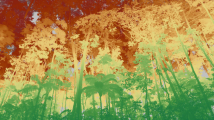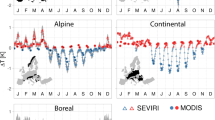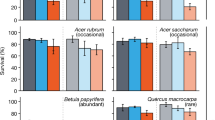Abstract
Tree canopies are one of the most recognizable features of forests, providing shelter from external influences to a myriad of species that live within and below the tree foliage. Canopy disturbances are now increasing across European forests, and climate-change-induced drought is a key driver, together with pests and pathogens, storms and fire. These disturbances are opening the canopy and exposing below-canopy biodiversity and functioning to novel light regimes—spatial and temporal characteristics of light distribution at forest floors not found previously. The majority of forest biodiversity occurs in the shade within and below tree canopies, and numerous ecosystem processes are regulated at the forest floor. Altered light regimes, in interaction with other global change drivers, can thus strongly impact forest biodiversity and functioning. As recent European droughts are unprecedented in the past two millennia, and this has initiated probably the largest pulse of forest disturbances in almost two centuries, we urgently need to quantify, understand and predict the impacts of novel light regimes on below-canopy forest biodiversity and functions. This will be a crucial element in delivering much-needed information for policymakers and managers to adapt European forests to future no-analogue conditions.
This is a preview of subscription content, access via your institution
Access options
Access Nature and 54 other Nature Portfolio journals
Get Nature+, our best-value online-access subscription
$29.99 / 30 days
cancel any time
Subscribe to this journal
Receive 12 digital issues and online access to articles
$119.00 per year
only $9.92 per issue
Buy this article
- Purchase on Springer Link
- Instant access to full article PDF
Prices may be subject to local taxes which are calculated during checkout



Similar content being viewed by others
References
Lowman, M. D. & Wittman, P. K. Forest canopies: methods, hypotheses, and future directions. Annu. Rev. Ecol. Syst. 27, 55–81 (1996).
Gilliam, F. (ed.) The Herbaceous Layer in Forests of Eastern North America (Oxford Univ. Press, 2014).
De Frenne, P. et al. Global buffering of temperatures under forest canopies. Nat. Ecol. Evol. 3, 744–749 (2019).
Senior, R. A., Hill, J. K., Benedick, S. & Edwards, D. P. Tropical forests are thermally buffered despite intensive selective logging. Glob. Change Biol. 24, 1267–1278 (2018).
Frey, S. J. K. et al. Spatial models reveal the microclimatic buffering capacity of old-growth forests. Sci. Adv. 2, e1501392 (2016).
Verheyen, K. et al. Driving factors behind the eutrophication signal in understorey plant communities of deciduous temperate forests. J. Ecol. 100, 352–365 (2012).
Boyle, M. J. W. et al. Localised climate change defines ant communities in human-modified tropical landscapes. Funct. Ecol. 35, 1094–1108 (2021).
De Frenne, P. et al. Forest microclimates and climate change: importance, drivers and future research agenda. Glob. Change Biol. 27, 2279–2297 (2021).
De Frenne, P. et al. Microclimate moderates plant responses to macroclimate warming. Proc. Natl Acad. Sci. USA 110, 18561–18565 (2013).
Zellweger, F. et al. Forest microclimate dynamics drive plant responses to warming. Science 368, 772–775 (2020).
McDowell, N. G. et al. Pervasive shifts in forest dynamics in a changing world. Science 368, eaaz9463 (2020).
Senf, C. & Seidl, R. Persistent impacts of the 2018 drought on forest disturbance regimes in Europe. Biogeosciences 18, 5223–5230 (2021).
Ceccherini, G. et al. Abrupt increase in harvested forest area over Europe after 2015. Nature 583, 72–77 (2020).
State of Europe’s Forests 2020, https://foresteurope.org/state-europes-forests-2020/ (Forest Europe, 2020).
Pretzsch, H., Biber, P., Schütze, G., Uhl, E. & Rötzer, T. Forest stand growth dynamics in central Europe have accelerated since 1870. Nat. Commun. 5, 4967 (2014).
Senf, C. & Seidl, R. Mapping the forest disturbance regimes of Europe. Nat. Sustain. 4, 63–70 (2021).
Hartmann, H. et al. Climate change risks to global forest health: emergence of unexpected events of elevated tree mortality worldwide. Annu. Rev. Plant Biol. 73, 673–702 (2022).
Patacca, M. et al. Significant increase in natural disturbance impacts on European forests since 1950. Glob. Change Biol. 29, 1359–1376 (2023).
Samaniego, L. et al. Anthropogenic warming exacerbates European soil moisture droughts. Nat. Clim. Change 8, 421–426 (2018).
Büntgen, U. et al. Recent European drought extremes beyond Common Era background variability. Nat. Geosci. 14, 190–196 (2021).
Vicente-Serrano, S. M. et al. A new global 0.5 gridded dataset (1901–2006) of a multiscalar drought index: comparison with current drought index datasets based on the Palmer Drought Severity Index. J. Hydrometeorol. 11, 1033–1043 (2010).
Brodribb, T. J., Powers, J., Cochard, H. & Choat, B. Hanging by a thread? Forests and drought. Science 368, 261–266 (2020).
Brodribb, T. J. & Cochard, H. Hydraulic failure defines the recovery and point of death in water-stressed conifers. Plant Physiol. 149, 575–584 (2009).
Nagel, T. A. et al. The natural disturbance regime in forests of the Dinaric Mountains: a synthesis of evidence. For. Ecol. Manage. 388, 29–42 (2017).
Sousa-Silva, R. et al. Tree diversity mitigates defoliation after a drought-induced tipping point. Glob. Change Biol. 24, 4304–4315 (2018).
Pollastrini, M., Puletti, N., Selvi, F., Iacopetti, G. & Busotti, F. Widespread crown defoliation after a drought and heat wave in the forests of Tuscany (central Italy) and their recovery—a case study from summer 2017. Front. For. Glob. Change 2, 74 (2019).
Anderegg, W. R. et al. Climate-driven risks to the climate mitigation potential of forests. Science 368, eaaz7005 (2020).
Senf, C. et al. Canopy mortality has doubled in Europe’s temperate forests over the last three decades. Nat. Commun. 9, 4978 (2018).
Seidl, R. et al. Forest disturbances under climate change. Nat. Clim. Change 7, 395–402 (2017).
Roberts, M. R. Response of the herbaceous layer to natural disturbance in North American forests. Can. J. Bot. 82, 1273–1283 (2004).
Sayer, E. J., Heard, M. S., Grant, H. K., Marthews, T. R. & Tanner, E. V. J. Soil carbon release enhanced by increased tropical forest litterfall. Nat. Clim. Change 1, 304–307 (2011).
Nilsson, M. C. & Wardle, D. A. Understory vegetation as a forest ecosystem driver: evidence from the northern Swedish boreal forest. Front. Ecol. Environ. 3, 421–428 (2005).
Landuyt, D. et al. The functional role of temperate forest understorey vegetation in a changing world. Glob. Change Biol. 25, 3625–3641 (2019).
Lendzion, J. & Leuschner, C. Temperate forest herbs are adapted to high air humidity—evidence from climate chamber and humidity manipulation experiments in the field. Can. J. For. Res. 39, 2332–2342 (2009).
Hardwick, S. R. et al. The relationship between leaf area index and microclimate in tropical forest and oil palm plantation: forest disturbance drives changes in microclimate. Agric. For. Meteorol. 201, 187–195 (2015).
Zellweger, F. et al. Seasonal drivers of understorey temperature buffering in temperate deciduous forests across Europe. Glob. Ecol. Biogeogr. 28, 1774–1786 (2019).
De Frenne, P. et al. Light accelerates plant responses to warming. Nat. Plants 1, 15110 (2015).
Dietz, L. et al. Windstorm‐induced canopy openings accelerate temperate forest adaptation to global warming. Glob. Ecol. Biogeogr. 29, 2067–2077 (2020).
Hylander, K., Greiser, C., Christiansen, D. M. & Koelemeijer, I. A. Climate adaptation of biodiversity conservation in managed forest landscapes. Conserv. Biol. 36, e13847 (2022).
Williams, J. W. & Jackson, S. T. Novel climates, no‐analog communities, and ecological surprises. Front. Ecol. Environ. 5, 475–482 (2007).
Hanewinkel, M., Cullmann, D. A., Schelhaas, M. J., Nabuurs, G. J. & Zimmermann, N. E. Climate change may cause severe loss in the economic value of European forest land. Nat. Clim. Change 3, 203–207 (2013).
Batllori, E. et al. Forest and woodland replacement patterns following drought-related mortality. Proc. Natl Acad. Sci. USA 117, 29720–29729 (2020).
Fung Au, T. et al. Younger trees in the upper canopy are more sensitive but also more resilient to drought. Nat. Clim. Change 12, 1168–1174 (2022).
Bennett, A. C., McDowell, N. G., Allen, C. D. & Anderson-Teixeira, K. J. Larger trees suffer most during drought in forests worldwide. Nat. Plants 1, 15139 (2015).
Gentilesca, T., Camarero, J. J., Colangelo, M., Nolè, A. & Ripullone, F. Drought-induced oak decline in the western Mediterranean region: an overview on current evidences, mechanisms and management options to improve forest resilience. iForest 10, 796–806 (2016).
Schuldt, B. et al. A first assessment of the impact of the extreme 2018 summer drought on central European forests. Basic Appl. Ecol. 45, 86–103 (2020).
Bachofen, C. et al. Stand structure of central European forests matters more than climate for transpiration sensitivity to VPD. J. Appl. Ecol. 60, 886–897 (2023).
Segar, J. et al. Divergent roles of herbivory in eutrophying forests. Nat. Commun. 13, 7837 (2022).
Blondeel, H. et al. The need for an understory decision support system for temperate deciduous forest management. For. Ecol. Manage. 480, 118634 (2021).
Findlater, K., Kozak, R. & Hagerman, S. Difficult climate-adaptive decisions in forests as complex social–ecological systems. Proc. Natl Acad. Sci. USA 119, e2108326119 (2022).
Thom, D. et al. The impacts of climate change and disturbance on spatio-temporal trajectories of biodiversity in a temperate forest landscape. J. Appl. Ecol. 54, 28–38 (2017).
Koelemeijer, I. A. et al. Interactive effects of drought and edge exposure on old-growth forest understory species. Landsc. Ecol. 37, 1839–1853 (2022).
Qie, L. et al. Drought cuts back regeneration in logged tropical forests. Environ. Res. Lett. 14, 045012 (2019).
Verheyen, K. et al. Combining biodiversity resurveys across regions to advance global change research. Bioscience 67, 73–83 (2017).
Bruelheide, H. et al. sPlot—a new tool for global vegetation analyses. J. Veg. Sci. 30, 161–186 (2019).
Archaux, F. & Wolters, V. Impact of summer drought on forest biodiversity: what do we know? Ann. For. Sci. 63, 645–652 (2006).
Hoover, D. L., Wilcox, K. R. & Young, K. E. Experimental droughts with rainout shelters: a methodological review. Ecosphere 9, e02088 (2018).
Bugmann, H. & Seidl, R. The evolution, complexity and diversity of models of long-term forest dynamics. J. Ecol. 110, 2288–2307 (2022).
Rammer, W. & Seidl, R. A scalable model of vegetation transitions using deep neural networks. Methods Ecol. Evol. 10, 879–890 (2019).
Sanczuk, P. et al. Microclimate and forest density drive plant population dynamics under climate change. Nat. Clim. Change 13, 840–847 (2023).
Calders, K. et al. Terrestrial laser scanning in forest ecology: expanding the horizon. Remote Sens. Environ. 251, 112102 (2020).
Webster, C., Essery, R., Mazzotti, G. & Jones, T. Using just a canopy height model to obtain lidar-level accuracy in 3D forest canopy shortwave transmissivity estimates. Agric. For. Meteorol. 338, 109429 (2023).
EU Forest Strategy to 2030, https://environment.ec.europa.eu/strategy/forest-strategy_en (European Commission, accessed 9 June 2023).
Acknowledgements
I thank my colleagues at the Forest & Nature Lab and J. Lenoir, F. Zellweger, R. Seidl, T. Jucker, F. Rodríguez-Sánchez, Ø. Opedal, S. Caluwaerts, M. Baele, D. Miralles, K. Calders and H. Verbeeck for extensive discussions and comments on earlier versions of this idea and/or manuscript. I also thank K. De Pauw, C. Greiser, W. Maes, T. Nagel, F. Selvi, F. Rodríguez-Sánchez and P. Sanczuk for help with the figures. I received funding from the European Research Council (ERC) under the European Union’s Horizon 2020 research and innovation programme (ERC Starting Grant FORMICA 757833).
Author information
Authors and Affiliations
Corresponding author
Ethics declarations
Competing interests
The author declares no competing interests.
Peer review
Peer review information
Nature Ecology & Evolution thanks Nidhi Vinod, Henry Adams and Marion Pfeifer for their contribution to the peer review of this work.
Additional information
Publisher’s note Springer Nature remains neutral with regard to jurisdictional claims in published maps and institutional affiliations.
Extended data
Extended Data Fig. 1 Conceptual diagram showing how novel combinations of levels of light, and frequencies, return intervals, extent, and durations of high light lead to novel light-regimes.
In this example, the high-light return interval (X-axis) and size of the area of high light (Y-axis) increase when entire regions are hit more frequently by summer droughts due to anthropogenic climate change leading to large-scale tree defoliation and mortality. The zone of novel light regimes is shaded in green. Similar examples can be made with other spatial and temporal characteristics of light distribution at forest floors not found previously.
Rights and permissions
Springer Nature or its licensor (e.g. a society or other partner) holds exclusive rights to this article under a publishing agreement with the author(s) or other rightsholder(s); author self-archiving of the accepted manuscript version of this article is solely governed by the terms of such publishing agreement and applicable law.
About this article
Cite this article
De Frenne, P. Novel light regimes in European forests. Nat Ecol Evol 8, 196–202 (2024). https://doi.org/10.1038/s41559-023-02242-2
Received:
Accepted:
Published:
Issue Date:
DOI: https://doi.org/10.1038/s41559-023-02242-2



